What is a BDC?
A Bullet Drop Compensator, or BDC, is an elevation knob on your scope that is marked specifically to compensate for the drop of a single caliber and loading at various ranges. Essentially, it is your "come-ups" but marked nicely on your elevation dial and not on a card taped to your stock or inside of your flip up cover. BDC dials are normally marked with single numbers, 1,2,3,4,5... that represent the "hundreds" of yards or meters. 1 = 100y, 2 = 200y etc. Some dials have enough room to actually mark them with 500, or 600, etc. With scopes that have .25 MOA type adjustments, or .125 (1/8) the turrets need to be tall to get to any significant ranges because it will take multiple revolutions to get to long ranges. This is when you will see numbers stacked on a dial as shown below:
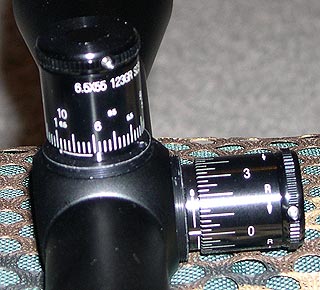
Leupold custom shop bdc
There are a few scope manufacturers that have knobs with 1 MOA adjustments in the elevation. Leupold M3 and Burris 6-24x XTR are two commercially available scopes with 1 MOA elevation adjustments. The M3 knob is a BDC, the XTR knob is not. With 1 MOA of elevation per click, you can typically fit 60 MOA per one rotation. By having that many adjustments in a single revolution, you are able to fit a 308's trajectory out to 1000 yards or meters into a single revolution at the cost of decreased precision per click. In example, one click at 800 yards is a full 8" of bullet impact shift. Pictured below is the knob of the leupold M3 as found on their 10x40mm. This is the scope that is used on the US Army M24 and you will notice the knob is marked M118, which is the exact ammo the knob is set for. This particular BDC dial is calibrated in meters.
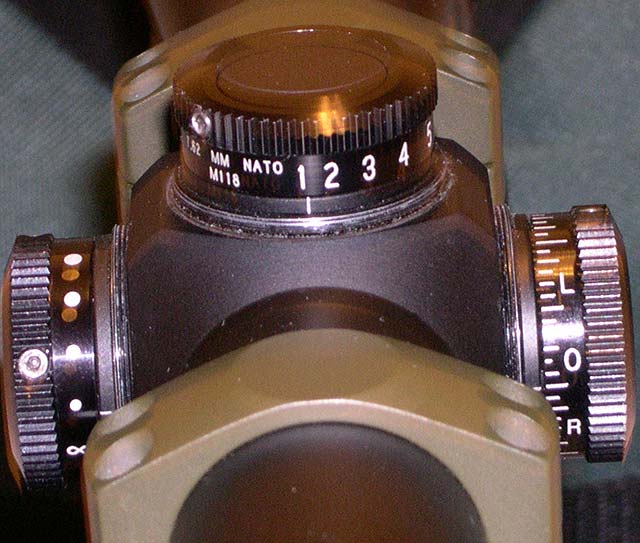
Leupold M3 10x
So, who else makes BDC's? Not many scope manufacturers do, but, lucky for us, there is a company out there that makes custom BDC knobs for many scopes that have target knobs. The company is Kenton Industries. They not only will make BDC knobs for other scope manufacturers, but they will make them to your specs in terms of what caliber and loading you want. If you want a BDC for a hand loaded 168gr 7mm Remington Mag load, they can make one for you. I have had several knobs made by them and have worked with them on other projects and they do excellent work. Feel free to let them know you found out about them from Sniper Central. Here is a picture of one of their knobs:
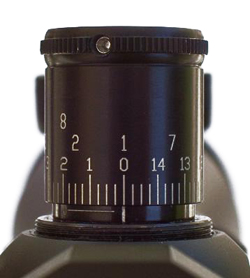
Kenton Industries Custom BDC knob
Incidentally, Leupold started offering the same service for their scopes. You can have a BDC knob made for any caliber. They are more expensive than Kenton, and they only make them (obviously) for their own scopes, but they are excellent knobs also. The first picture above of a BDC knob on this page is a Leupold costom shop knob set for the Lapua 123gr 6.5x55 Swedish load.
Why use a BDC?
Many people have been taught to make come-up charts to mark how many clicks it takes to change your impact from 100 to 200 yards (or meters) and how many from 200 to 300, and from 300 to 400, etc. Then if your scope is set to be point of aim, point of impact at 300 yards, and you need to shoot at 600, you look at your chart, and then add up how many clicks it takes to go from 300 to 400, 400 to 500, 500 to 600 and then make those adjustments. Obviously, there are going to be a lot of clicks if your scope is .25 MOA per click and even more if they are .125 per click. The other problem is that you are now relying on your memory to tell you if you are set at 600, or was that 500 yards? In stressful situations, like combat or even competition shooting, your mind is already taxed and remembering where your scope is set may be difficult. BDC's will help in these regards, but in reality, the biggest reason to use BDC's is probably just for simplicity sake. In combat or police call out duty, you want everything as simple as possible. You want to know exactly where your rifle is set to hit when you pull that trigger, and having nice marks on your elevation knobs helps tremendously. You only need to glance up at your elevation dial to know, versus glancing at a come-up chart, and hoping you remember correctly where you had your scope last set.
For serious field work, I personally like the 1 MOA adjustment BDC's. The number of clicks is drastically reduced and it is very quick and easy to go from 100 to 1000 meters in less than 1 revolution of the dial. For police work, the 1 MOA dials are not desirable, as precision is much more important, and the ranges much less than military work. I did take a M24 with a 1 MOA M3 knobbed scope through a Law Enforcement sniper school and passed without problems, but I was also holding a tad low or high in certain situations. This is not something I would want to do all the time, but it can be done.
Why NOT use a BDC?
The biggest obvious problem with BDC's is that they are accurate for only one loading of one caliber in one give environmental condition (temp, humidity, etc). They will be close for others, like if the weather is only a few degrees different, or some loadings in that caliber may be close, but they are truly accurate for only one. Because they are close, they obviously can be used in many conditions, but one must still be aware of things like the humidity being significantly higher and you must add a little elevation at longer ranges. But if one likes to shoot many different loads through a rifle, or the scope gets mounted on several different rifles during a shooting season, then BDC's are probably not for you.
The 1 MOA single turn BDC's are also not entirely suitable for precision work. If you are shooting for bullseyes, a full MOA or even a .5 MOA may not be accurate enough for you. Lots of times the decision for me comes down to the use of the rifle, if it is a serious field rifle where most shooting is going to be unknown distance, than a BDC is my choice, where as if the rifle is mainly going to be used at the range for shooting groups, then traditional target knobs usually will work better. Also, with BDC's, if you are a handloader you can match BC's from different bullets in different calibers and load them to similar velocities to have your BDC be effective for more than one caliber.
What about BDC reticules?
The last thing I wanted to mention was BDC reticules. The old Springfield Armory and current Sheperd scopes kind of started the idea of actually designing the reticule to have marks for the various ranges for a cartridge. The SA scope had different scope models for 308 168gr and 223 55gr loads. There have been a few more recent examples, like Burris' ballisticplex that try to provide a generic arc that many cartridges will come "close" to matching. It is not a bad idea and does work with minor tweaks for several loads. Leupold and Nikon have both introduced very similar reticules to the ballistic plex for 2006. The one big problem with reticule BDC's is that if you did want to exactly match a load, there is no easy way to change the reticule.... UNLESS you have a Leupold scope. On some of the higher end Leupold's, you can send in your scope to the Leupold custom shop with some load details and they will create a reticule to match it. The only down side is that it only goes to 500 yards. This is the reason why I have never had one made. The ballisticplex from Burris and the Nikon also only go to 500 yards. The ballistic mil-dot by Burris goes to 600 or 700 (depending on caliber) but still not quite where I would like to see them reaching out to for tactical work. If your scope does have target knobs, you could have a Kenton BDC knob made to compensate for ranges beyond the 500 of the reticule, but that could get confusing. The one advantage BDC reticules have over knob BDC's is that they are very fast. You do not need to reach up and adjust a knob, you just estimate the range and use the correct dot. Fast, easy and effective.
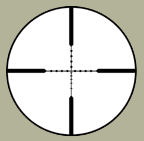 Burris Ballistic Mildot |
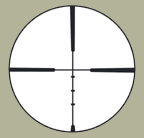 Burris Ballisticplex |
 Leupold LR Duplex, intended for 200y zero |